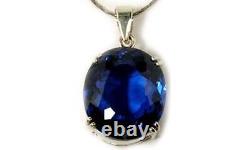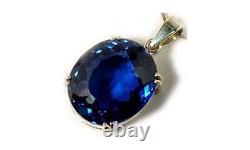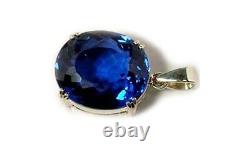
- Antique Imperial Russian
- Main Stone
- Material
- .875 Silver (4)
- 18k Gold (2)
- Bronze (4)
- Bronze, Glass (2)
- Ceramic & Porcelain (8)
- Ceramic, Porcelain (2)
- Enamel (59)
- Gemstone (3)
- Gold (38)
- Gold Handmade (2)
- Metal (17)
- Mixed Materials (4)
- Porcelain (16)
- Silk, Velvet, Wood (4)
- Silver (916)
- Silver 84 (3)
- Solid Gold (5)
- Solid Silver (9)
- Sterling Silver (2)
- Stone (23)
- Other (1833)
- Metal
- Style
- Antique (48)
- Art Deco (50)
- Art Nouveau (67)
- Band (11)
- Charm (7)
- Empire (79)
- Empire & Biedermeier (63)
- Imperial (13)
- Imperial Russia (9)
- Imperial Russian (77)
- Monogram Spoons (8)
- Pan Slavic (7)
- Pendant (54)
- Royal (7)
- Russian (86)
- Russian Empire (11)
- Russian Imperial (21)
- Slavic (17)
- Stud (8)
- Victorian (47)
- Other (2266)
- Type
- Vintage
Blue Topaz Pendant 41c Handcut Ancient Egypt Sun God Ra Magic Falcon Engrave Gem







Handcrafted Genuine Natural Russian Forty and Three-Quarter Carat Faceted Oval Cut Blue Topaz Semi-Precious Gemstone. Contemporary High Quality Sterling Silver Pendant Setting. ORIGIN: The Ural Mountains, Siberia, Russia. CLASSIFICATION: Hand Faceted Oval Cut Royal Blue Topaz.
APPROXIMATE WEIGHT : 40.77 carats. NOTES : Default chain is silver electroplate 16, 18, 20 or 24 inch (provided free). Sterling silver chains are also available in lengths from 16 to 24 inches. 14kt solid gold pendant setting together with 14kt gold fill and solid 14kt gold chains in lengths from 18 to 24 inches are available upon request. DETAIL: In the ancient world topaz came from Topazion, an Island in the Red Sea now called Zabargad.
In the ancient world, topaz was thought to protect against evil and to the ancient Egyptians, the sparkle of topaz symbolized "Ra", their sun god. In the latter Middle Ages small wine-yellow Saxonian Topaz were mined at Schneckenstein in the Erzgebirge Mountains in Saxony, Germany, and several rulers wore these specimens in jewelry.The Germans believed that the yellow topaz prevented bad dreams, calmed passions, ensured faithfulness and, when taken in wine, cured asthma and insomnia. It was also believed that the figure of a falcon engraved upon a topaz talisman would bring the wearer the goodwill and kindness of the gods. Here's a magnificent, sparkling royal blue topaz semi-precious gemstone from the Ural Mountains of Russia. Gorgeous, vibrant, and vividly hued, this striking semi-precious gemstone is of very high quality and possesses breathtaking luster. It has been hand cut into a sparkling, brilliant, faceted oval cut gemstone with lots of flash and depth.
As you can see, this is an exceptionally good quality gemstone. Certainly to the eye it is nothing less than perfect, it is truly a beautiful, sumptuous, and regal-sized semi-precious gemstone. The gemstone was hand crafted and faceted by a Russian artisan, part of a centuries-long heritage renown for the production of the elaborate gemstones and jewelry of the Czars of Medieval, Renaissance, and Victorian Russia. Under magnification the gemstone shows the unmistakable characteristics of having been hand crafted.The coarseness of the handcrafted finish is considered appealing to most gemstone collectors, and is not considered a detriment, or to detract from the value of a gemstone. These characteristics are not only expected of hand-finished gemstones, most serious collectors consider such gemstones more desirable, possessed of greater character and uniqueness when compared to today's cookie-cutter mass-produced machine-faceted gemstones. Unlike today's computer controlled machine produced gemstones that approach flawlessness in a perfect finish, the cut and finish of a handcrafted gemstone such as this is the cultural legacy passed onwards by artisans who lived centuries ago. Though Russia does have some virtually unique deposits of naturally colored dark blue topaz, most blue topaz this dark in color has been heat-treated, so it would be safe to assume that this gemstone has likely been heated in order to achieve this deep blue color (of course heating gemstones is no more undesirable or uncommon than is heating/baking bread - it's been done since before recorded history began).
The setting is of contemporary origin. It is a high quality setting manufactured of solid sterling silver, and can be reset into 14kt gold if requested.
The default chain is silver electroplated 24 inch. However we do have solid sterling silver (as well as 14kt gold and gold fill) chains available in lengths between 16 and 24 inches available upon request. This gemstone has great luster and sparkle, and to the eye is completely transparent, but one cannot say with absolute certainty that it is absolutely flawless. True, any blemishes it possesses are not visible to the naked eye, and even at 600% as in these photo enlargements here (or under a 5x jeweler's loupe) there are no discernible flaws. However we hesitate to use the word "flawless", as sooner or later blemishes will show up at higher levels of magnification with almost every natural gemstone.
An absolutely flawless gemstone is very rare in nature (and usually turns out to be synthetic). However the gemstone can be characterized at a minimum, to use trade jargon, as "loupe clean".
To the eye it is indeed flawless; even to a jeweler's loupe it is clean. Close examination with a jeweler's loupe will however reveal occasional slight irregularities in the faceting and finish. Naturally these characteristics are expected of hand-finished gemstones.
However for most, the unique nature and character of hand-crafted gemstones such as this more than makes up for imperfect finishes which by and large, are only noticed under high magnification. HISTORY OF TOPAZ: It is believed that topaz was known during the early Bronze Age, as the mining of topaz is strongly associated with tin mining, a mineral needed to create bronze (an alloy of copper and tin). Archaeologists are certain that the people in the Middle-Eastern Bronze Age would have known about this gemstone.However the first historical descriptions of topaz were from the classical Mediterranean. The origin of topaz in the ancient Mediterranean was a small island in the Red Sea known as "Topazion", a Greek term meaning "to guess".
In Arabic the same term means the subject of the search. This reflects the fact that the island was typically obscured by fog, making it difficult for early navigators to find. Typically yellow, topaz in the ancient world was held as a talisman to protect against evil and was used to treat many different physical ailments including asthma. The Greeks and Romans greatly valued topaz as a gemstone, even believing that the gemstone would improve the wearer's eyesight. Ancient Romans also credited topaz with preventing sickness of the chest and it was also used to treat abdominal pain. The ancient Greeks believed topaz would give great strength to whomsoever wore the stone, and was also worn as an amulet to ward off enchantment ("spells" or "curses"). The ancient Greeks also believed that wearing topaz would dispel sadness and strengthen the wearer's intellect.There are also frequent references from ancient Greek sources which claim that wearing topaz rendered the wearer invisible. In Rome and the Early Medieval world, topaz was associated with Apollo and/or Jupiter, as Topaz was associated with the sun, and both Jupiter and Apollo were solar deities. Both Julius Caesar and his heir Octavian Augustus held Apollo in special reverence.
Augustus credited Apollo with his victory over Marc Antony, and erected a magnificent temple to Apollo at Actium overlooking the site of the famous naval battle, as well as an even grander temple on the Palatine in Rome. The gemstone was also described by the first century Roman historian and naturalist "Pliny the Elder". There are also many biblical references to "topaz". Topaz was one of the twelve stones selected by Aaron for his priestly breastplate, representing the twelve tribes of ancient Israel.
He placed it there as the second stone in the first row of stones. Topaz is also found as one of the stones in the book of Revelations as one of the stones of the apocalypse (one of the gemstones which form the foundations of the twelve gates to the Holy City of the New Jerusalem). To ancient Christians topaz was regarded as a symbol of uprightness and virtue. In ancient Egypt the golden glow of yellow topaz symbolized "Ra", their sun god. This made topaz a very powerful amulet that protected the faithful against harm. In ancient India topaz was regarded as a sacred gemstone. Ancient Hindus believe that worn as a pendant above the heart topaz assured long life, beauty and intelligence (and would also alleviate thirst). Wearing topaz in a ring was believed to lengthen one's life and forestall death (or alternatively to prevent sudden death).Worn around the neck, topaz was also thought to cure madness. If also mounted in gold and worn around the neck, it was believed to dispel enchantments and calm nocturnal fears.
Worn as a protective talisman topaz was said to instantly lose its color to indicate that poisoned food or drink was present, thus protecting its owner. It was also believed to be an effective talisman against accidents. Topaz was also regarded as a talisman for travelers, protecting them from homesickness and danger. In the Medieval World, it was believed that wearing a topaz talisman conferred to the wearer special powers over animals. Topaz was also used by shamans and seers who believed that topaz and encouraged clairvoyance and psychic skills, and enabled the wearer to perceive the intentions and motives of the people around them. It was also believed to make men handsome and intelligent and sterile women fertile and happy. There were as well medicinal uses for topaz in the Middle Ages. Topaz was believed to be able to actually absorb the heat of a fever. Topaz was also believed to ease the inflammations, discomfort and pain associated with arthritis. However the curative powers of topaz were believed to weaken and strengthen in response to changing phases of the moon. Topaz is found in yellow, orange, green, blue, red, and white (colorless) hues. The highest grade topaz comes from Sri Lanka and India, the Ural Mountains in Russia, Brazil, and in the U. From Maine, Colorado, California, and Utah.The most popular color for topaz gemstones is light blue, and the most costly is a rich orange-yellow, resembling the color of sherry wine, known as "imperial" topaz (sometimes referred to as "precious topaz"). Sherry-colored topaz is called "imperial" topaz in honor of the Russian Tsar who owned the mining fields of topaz in the Urals Mountain range (in Siberia, Russia), and the best quality topaz were reserved for the emperor and his family.
Topaz is one of the hardest minerals in nature, and for that reason, highly valued as a gemstone. Throughout the history of the ancient world, gemstones were believed capable of curing illness and providing protection. Found in Egypt dated 1500 B.
The "Papyrus Ebers" offered one of most complete therapeutic manuscripts containing prescriptions using gemstones and minerals. Gemstones were not only valued for their medicinal and protective properties, but also for educational and spiritual enhancement. In the ancient world topaz was thought to heal both physical and mental disorders, and to prevent death. Topaz was also believed to assure beauty, fidelity and long life.Topaz was also used to treat medical ailments. Topaz powdered and drunk in wine, cured asthma, tuberculosis, insomnia, burns and hemorrhages. The twelfth century German Prophetess/Visionary Mystic/Catholic Saint "Hildegard" had an unusual prescription for improving failing vision which involved soaking a topaz in wine, then rubbing the eyes with the gemstone and drinking the wine. Topaz was also regarded effective against bleeding and heart disease, as well as a cure for rheumatism, gout, and soreness in the joints. Wearing topaz was believed to aid the spinal column and help steady and regulate the action of the heart.
It was used to treat bleeding and believed helpful to promote health in the glandular systems of the body. It was also believed to improve eyesight. Topaz was also used in treating infections, deafness, goiter, hemorrhage, circulatory problems, digestive problems, combating anorexia, restoring the sense of taste, stimulating metabolism and more.
I was regarded as especially effective in treating hemorrhoids if it were worn on the left arm. Last (but certainly not least), men were believed to become more virile when wearing topaz! On the metaphysical plane, the ancient world regarded topaz as a stone of true love and capable of attracting success in all endeavors. Topaz was believed to promote creativity and individuality, and was thought excellent for promoting concentration.
It was also attributed with the power to replace negativity with love and joy, stimulating a brighter outlook on life. It is traditionally known as a stone of love and good fortune, bringing successful attainment of goals. It was said to be especially effective when set in gold and bound to the left arm. When worn as an amulet, topaz drove away sadness, added intelligence and gave courage. On the emotional plane, topaz was believed to be useful for treating depression. It was believed to help people alleviate their fears, and was used to treat psychosomatic illnesses. It was regarded as useful in balancing emotions, helping those who go from one extreme to another. Topaz was also highly recommended for healing a person who was suffering from shock or trauma, and was regarded as a panacea for those whose lives contained abnormal amounts of stress or tension.In particular, blue topaz was believed extremely helpful to those who were angry. Blue topaz was regarded as possessing the power of the moon and elemental water. Blue topaz was believed effective in helping the wearer to release their anger, and to bring one's emotional pain to the surface. Modern practitioners believe that topaz assists in general tissue regeneration and in the treatment of hemorrhages.
It also believed to stimulate poor appetite and aid in the treatment of blood disorders. In India topaz is still used to treat tonsillitis, whooping cough, and mumps. We package as well as anyone in the business, with lots of protective padding and containers.
Please ask for a rate quotation. ABOUT US : Prior to our retirement we used to travel to Eastern Europe and Central Asia several times a year seeking antique gemstones and jewelry from the globe's most prolific gemstone producing and cutting centers.
Most of the items we offer came from acquisitions we made in Eastern Europe, India, and from the Levant (Eastern Mediterranean/Near East) during these years from various institutions and dealers. Though we have a collection of ancient coins numbering in the tens of thousands, our primary interests are ancient/antique jewelry and gemstones, a reflection of our academic backgrounds. Though perhaps difficult to find in the USA, in Eastern Europe and Central Asia antique gemstones are commonly dismounted from old, broken settings - the gold reused - the gemstones recut and reset. Before these gorgeous antique gemstones are recut, we try to acquire the best of them in their original, antique, hand-finished state - most of them originally crafted a century or more ago.
We believe that the work created by these long-gone master artisans is worth protecting and preserving rather than destroying this heritage of antique gemstones by recutting the original work out of existence. That by preserving their work, in a sense, we are preserving their lives and the legacy they left for modern times. Far better to appreciate their craft than to destroy it with modern cutting. Not everyone agrees - fully 95% or more of the antique gemstones which come into these marketplaces are recut, and the heritage of the past lost.

